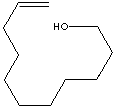| UNDECYLENIC ALCOHOL | ||
|
PRODUCT IDENTIFICATION |
||
| CAS NO. | 112-43-6 |
|
| EINECS NO. | 203-971-0 | |
| FORMULA | C11H22O | |
| MOL WT. | 170.29 | |
| H.S. CODE | 2905.19 | |
|
TOXICITY |
||
| SYNONYMS | 1-Undecen-11-ol; 10-Undecenol; 10-Undecylen-1-ol; | |
| omega-Undecenyl alcohol; 11-Hydroxy-1-undecene; omega-Undecylenyl alcohol; Undecylenyl alcohol; 10-Undecene-1-ol; | ||
|
SMILES |
||
|
CLASSIFICATION |
|
|
|
PHYSICAL AND CHEMICAL PROPERTIES |
||
| PHYSICAL STATE | clear liquid | |
| MELTING POINT | ||
| BOILING POINT | 132 - 133 at 15 hPa | |
| SPECIFIC GRAVITY | 0.84 - 0.85 | |
| SOLUBILITY IN WATER | ||
| pH | ||
| VAPOR DENSITY | ||
|
AUTOIGNITION |
| |
|
NFPA RATINGS |
Health: 1; Flammability: 3; Reactivity: | |
|
REFRACTIVE INDEX |
1.448 | |
| FLASH POINT |
| |
| STABILITY | Stable under ordinary conditions | |
|
APPLICATIONS |
||
|
Undecylenic Acid is an unsaturated carboxylic acid. The molecules of most natural fatty acids have an even number of carbon chains due to the linkage together by ester units. Analogous compounds of odd numbers carbon chain fatty acids are supplemented synthetically. Pelargonic acid, C-9 odd numbers carbon chain fatty acid, is relatively high cost fatty acid. Pelargonic acid can be prepared by ozonolysis which uses ozone is to cleave the alkene bonds. Eexample of ozonolysis in commerce is the production of odd carbon number carboxylic acids such as azelaic acid and pelargonic acid and simple carboxylic acids such as formic acid and oxalic acid. When ricinoleic acid, an unsaturated fatty acid containing one -OH group, derived from castor oil, is pyrolyzed by heating in the absence of air, it breaks down to give undecylenic acid and n-heptaldehyde. This product has the bifunctionality, odd carbon number and the position of its unsaturated solid bond at the end of the chain, makes it a versatile tool for chemical synthesis. It's anti-fungal properties are useful in cosmetics and pharmaceuticals. Undecylenic Acid and its aldehyde are used to formulate perfumes. Undecylenic acid and its zinc salt are used for the treatment and prevention of superficial fungus infections of the skin, primarily tinea pedis as well as relieves itching, burning and irritation. Undecylenic Alcohol is one of common ingredient in flavor and fragrance. Odor description: floral, ozone, waxy. |
||
| SALES SPECIFICATION | ||
|
APPEARANCE |
clear liquid | |
| ASSAY |
98.0% min | |
| MOISTURE |
0.3% max | |
| TRANSPORTATION | ||
| PACKING | 170kgs in drum | |
| HAZARD CLASS | ||
| UN NO. | ||
| GENERAL DESCRIPTION OF FATTY ALCOHOL |
||
Fatty alcohols, derived from natural fats and oils, are high molecular straight
chain primary alcohols. They include lauryl (C12), MyrIstyl (C14), Cetyl ( or
palmityl: C16), stearyl (C18), Oleyl (C18, unsaturated), and Linoleyl (C18,
polyunsaturated) alcohols. There are synthetic fatty alcohols equivalent
physically and chemically to natural alcohols obtained from oleochemical sources
such as coconut and palm kernel oil. Fatty alcohols are emulsifiers and
emollients to make skin smoother and prevent moisture loss. Identical fatty
esters are used to improve rub-out of formulas and to control viscosity and
dispersion characteristics in cosmetics, personal care products and
pharmaceutical ingredients. As chemical intermediates, the primary use of fatty
alcohols are as raw material for the production of fatty sulfate salts and
alcohol ethoxylates for foaming and cleaning purposes in the field of detergent
industry. Chemical reactions of primary alcohols include esterifications,
ethoxylation, sulfation, oxidation and many other reactions. Their derivatives
and end use applications include;
Large amount of fatty alcohols are used as special solvents, fillers in plasticizer and insulating materials for the building industry. Fatty alcohols are used as ingredients in the industries of agricultural, foodstuff, metal processing, cosmetics, lube additive, pharmaceutical, rubber, textile, perfume and flavouring as well as synthetic detergent. |
||
